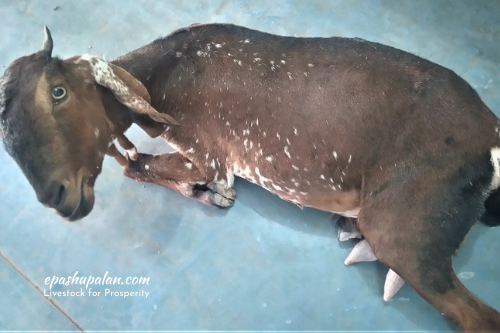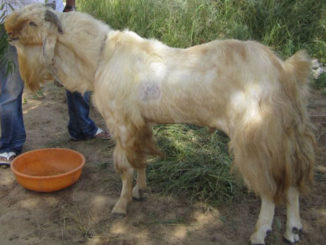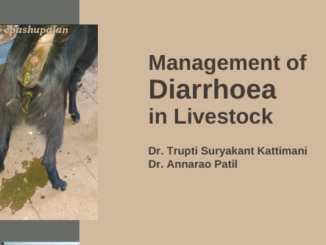Introduction
Goat provide multiple benefits to farmers in developing countries. Goat meat and milk are consumed locally among the poor in developing countries. Goat is considered poor man’s cow. Polioencephalomalacia (PEM) is a common metabolic disease of ruminents characterized by neuromuscular alterations and necrosis of the cerebral cortex. Its nutritional disorder in sheep and goats. Younger animals are more frequently affected than adults. Polioencephalomalacia may be acute or subacute.
Aetiology
The most common cause of PEM is thiamine deficiency. Thiamine, also known as vitamin B1. It is normally produced by bacteria in the rumen of goat on well-balanced roughage diets. Thiamine deficiency reduces energy availability to the brain, which cause brain degeneration called polioencephalomalacia or PEM. Kids on high concentrate rations or grazing lush pasture are more prone to thiamine deficiency because goat kids’ rumen is not fully functional. High levels of Sulphur in the feed and water such as goats grazing lucerne or fed concentrate diets that contain molasses are most susceptible for PEM. Lead toxicity, and water deprivation-sodium ion toxicity had been implicated in the development of polioencephalomalacia. Acute rumen acidosis can result in bacterial-mediated thiamine destruction in the rumen. Certain deworming drugs such as Levamisole and ivermectin as well as drugs such as amprolium and metronidazole can cause the condition. Mouldy hay or feed also leads to poor rumen function. Poisonous plants such as solanum, sorghum and bracken fern toxicity can predispose the condition. Certain pesticides such as carbaryl, chlorinated hydrocarbons toxicity also produce thiamine deficiency.
Clinical signs
Animal showed dull and depressed, anorexia, aimless wandering, severe dehydration, teeth grinding, the head is held in an elevated position. There is cortical blindness with absent menace response but normal bilateral pupillary light reflex. torticollis, lateral recumbency, convulsions and paddling of limbs. Nystagmus – flickering of eye, star grazing, head pressing and unable to stand and death.


Diagnosis of PEM
Diagnosis of suspected animals based on clinical signs, response to thiamine therapy and confirmed by necropsy findings. Confirmation of etiology or pathogenesis of disease requires laboratory testing of samples from affected animals. Assessment of thiamine status is difficult, and results should be interpreted with caution. Only few laboratories are capable of routinely measuring thiamine content of blood.
Differential diagnosis
The following conditions are excluded from PEM- Caprine arthritis encephalitis, listeriosis, enterotoxemia, pregnancy toxaemia, grain poisoning, plant poisoning, rabies, tetanus, water deprivation and sodium toxicosis.
Treatment of PEM
Treatment of PEM required dietary modification and thiamine therapy. Vit B1 (thiamine) intramuscular injection (10 – 20 mg/kg body weight) given every three hours for a total of five doses. Early cases respond within 6 to 8 hours with complete recovery in 24 hours. Goats not recovered by 72 hours will usually not fully recover. The administration of probiotics supplements assists with proper micro-organism balance and function of rumen. Dextrose normal saline (10ml/kg intravenous) and dexamethasone (0.5mg/kg IV) till recovery. Dexamethasone therapy used for reduced brain edema. Proper management and feeding support to animal fast recovery.
Prevention and control
During outbreak in herds, sufficient roughage and low concentrate diet should be provided. If the problems associated with high sulphur intake, all possible sources of sulphur, including diet and water should be avoided. Dietary supplementation of thiamine at 3-10 mg/kg feed has been recommended for prevention. Animals should be thiamine until normal rumen fermentation is re established. Feed a diet with at least 60% dry matter being fresh or green forage. Awareness about risk associated with grazing bracken fern toxicity. Do not use ammonia sulphate as acidity regulator in animal feed. Administer thiamine HCL 10-15 mg/kg to the affected animal every three to five years until recovery.
| The content of the articles are accurate and true to the best of the author’s knowledge. It is not meant to substitute for diagnosis, prognosis, treatment, prescription, or formal and individualized advice from a veterinary medical professional. Animals exhibiting signs and symptoms of distress should be seen by a veterinarian immediately. |






Be the first to comment